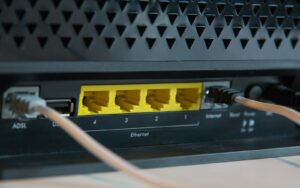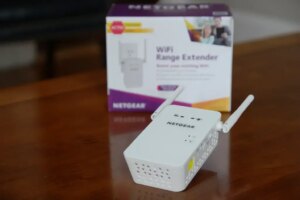A WiFi extender can be an excellent solution to improve your overall internet connectivity. Many WiFi extenders come equipped with an Ethernet port, offering additional options for extending your network’s reach and performance.
Key Takeaways
- WiFi extenders with Ethernet ports offer faster speeds, lower latency, and more reliable connections compared to wireless-only extenders.
- Proper placement and configuration of your extender are crucial for optimal performance.
- Consider the physical layout of your home, wiring requirements, and budget when choosing an extender with Ethernet.
- Alternative solutions like mesh WiFi systems, MoCA adapters, and powerline adapters may be viable options depending on your specific needs.
How a WiFi Extender Works
A WiFi extender is designed to extend the wireless network coverage area by rebroadcasting the signal from your main router. By placing the extender strategically between your router and the devices you want to connect, you can optimize the performance of your extended network.
For the best results, consider the following placement tips:
- Position the extender halfway between your router and the area with weak WiFi signal
- Avoid placing the extender near obstacles like thick walls, metal objects, or appliances that can interfere with the signal
- Ensure the extender is within range of your main router’s signal for a stable connection
See also: WiFi Mesh vs Extender vs Booster vs Repeater
The Benefits of Using an Ethernet Port on a WiFi Extender
While WiFi extenders primarily work wirelessly, many models feature an Ethernet port that can provide several advantages:
- Faster Connection Speeds: By connecting your devices directly to the extender via Ethernet, you can achieve faster speeds compared to wireless, allowing you to fully utilize your internet plan’s capabilities.
- Lower Latency and Reliable Connections: Ethernet connections offer lower latency and more reliable performance, making them ideal for bandwidth-intensive applications like online gaming and streaming high-quality video content.
- Unified Network: With an Ethernet connection, you can create a single, unified network without the need to switch between your main network and the extender’s network on your devices.
- Wired Device Connectivity: The Ethernet port on your extender allows you to connect wired devices like desktop PCs, smart TVs, and gaming consoles directly, providing them with better performance and stability.
Here are some of our recommended WiFi extenders with ethernet port.
Considerations When Using an Ethernet Port on Your WiFi Extender
Before setting up your WiFi extender with an Ethernet connection, keep the following considerations in mind:
- Gigabit Ethernet Port: Check if your extender has a Gigabit Ethernet port, which supports speeds up to 1000 Mbps (1 Gbps), for maximum performance.
- Extender Capabilities: Be aware of your extender’s overall capabilities and potential performance limitations, especially with cheaper or older models, as they may not fully support the speeds of your internet plan.
- Physical Layout and Wiring: Consider the physical layout of your home and the Ethernet wiring requirements. Running long Ethernet cables can be challenging and may not be feasible in all situations.
- Cost: WiFi extenders with Ethernet ports may come at a higher price point compared to those without, so factor this into your budget when making a purchase decision.
How to Connect Your WiFi Extender Using Ethernet
There are two main ways to utilize the Ethernet port on your WiFi extender:
- Wired Backhaul: Connect your extender directly to your main router using an Ethernet cable. This creates a dedicated, wired connection between the two devices, providing a stable and fast backhaul for your extended network.
- Connecting Wired Devices: Use the Ethernet port on your extender to connect wired devices directly. This is particularly useful for devices that don’t have WiFi capabilities or for those that require a more stable connection.
When setting up your extender with an Ethernet connection, consider the following tips:
- Use high-quality Ethernet cables rated for your desired speeds (e.g., Cat 5e or Cat6 for Gigabit connections)
- Ensure your extender is placed in a well-ventilated area to manage heat output, as Ethernet connections can generate more heat compared to wireless
Alternatives to WiFi Extenders with Ethernet
While WiFi extenders with Ethernet ports offer many benefits, there are alternative solutions for extending your network’s reach and performance:
- Mesh WiFi Systems: Mesh WiFi systems consist of multiple nodes that work together to create a seamless, whole-home WiFi coverage. They often support Ethernet backhaul and can be a more integrated solution compared to traditional extenders.
- MoCA Adapters: Multimedia over Coax Alliance (MoCA) adapters use your home’s existing coaxial cable wiring to create a wired network connection. They can be a good option if you have coaxial cables running to different rooms in your house.
- Powerline Adapters: Powerline adapters utilize your home’s electrical wiring to transmit data. By plugging one adapter into a power outlet near your router and another near the device you want to connect, you can create a wired network connection without running long Ethernet cables.
Below are some of our recommendations.
Consider the specific needs of your home, budget, and desired performance when choosing between these alternatives and a WiFi extender with Ethernet.
Troubleshooting Common Issues
If you encounter any issues while setting up or using your WiFi extender with Ethernet, try these troubleshooting tips:
- No Internet Connection: Double-check all cable connections and ensure your main router is functioning properly. Restart your devices in this order: modem, router, extender.
- Slow Speeds: Ensure your extender is placed in an optimal location, away from interference sources. Check if your devices support the same WiFi standard as your extender (e.g., 802.11ac).
- Extender Not Connecting: Verify that your extender is within range of your main router’s signal. Try resetting your extender to factory settings and setting it up again.
- Ethernet Device Not Connecting: Check if the Ethernet cable is securely connected and not damaged. Try using a different cable or port on your extender.
Tips for Optimizing Your WiFi Extender’s Performance
To ensure you’re getting the most out of your WiFi extender with Ethernet, consider the following tips:
- Use High-Quality Ethernet Cables: Invest in high-quality, shielded Ethernet cables (Cat 5e or Cat 6) to minimize interference and maximize performance.
- Avoid Obstacles and Interference: Place your extender away from obstacles like thick walls, metal objects, and appliances that can interfere with the WiFi signal.
- Update Firmware Regularly: Keep your extender’s firmware up to date to ensure optimal performance, security, and compatibility with the latest devices and standards.
- Experiment with Placement: If you’re not getting the desired results, try moving your extender to a different location or adjusting its antennas to find the sweet spot for your home’s layout
Conclusion
Incorporating an Ethernet connection into your WiFi extender setup can greatly enhance your network’s performance and coverage. By understanding the benefits, considerations, and setup process, you can make an informed decision on whether an extender with Ethernet is right for you.
Remember, the key to maximizing your WiFi coverage is finding the solution that best fits your unique home environment and connectivity needs. Don’t hesitate to explore your options and experiment with different configurations to achieve the best possible performance.
FAQs
Q: Can I use multiple Ethernet devices with my WiFi extender?
A: Yes, if your extender has multiple Ethernet ports, you can connect several wired devices simultaneously.
Q: Will connecting a device via Ethernet affect the WiFi performance for other devices?
A: No, connecting a device via Ethernet will not impact the WiFi performance for other devices connected wirelessly to the extender.
Q: Do I need special Ethernet cables to connect my devices to the extender?
A: For the best performance, use high-quality Ethernet cables rated for your desired speeds, such as Cat 5e or Cat 6 cables for Gigabit connections.













